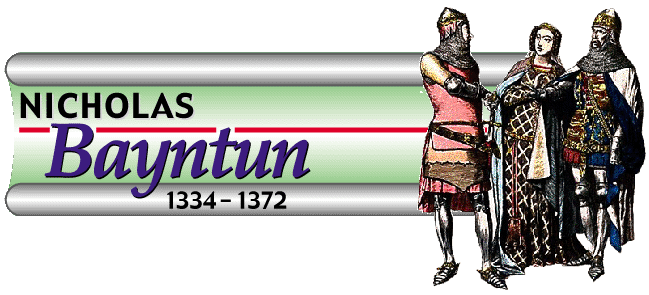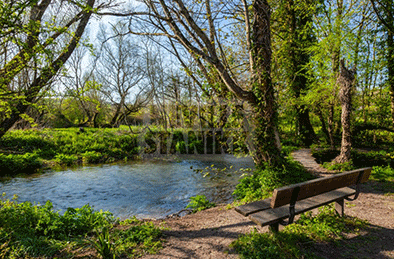
|
Timeline
1337: The Hundred Years’ War began between King Edward III of England and Philip VI of France which resulted, on and off, in a series of wars with France about the possessions in France of the English kings. 1339: King Edward III invaded France and won a number of battles. 1346: The English army defeat the French at the Battle of Crecy. 1348-1351: The Black Death ravaged Europe. It got its name from the black tumors it caused on the body. In England alone, this bubonic plague wiped out close to one third of the population. It is said the plague was spread by blood-sucking fleas that lived on rats. The fleas then transferred to humans when the rats died. Infected houses were marked with a cross and doctors were forced to wear leather masks to protect themselves. 1356: King Edward III captured the French King at Poitiers and forced him to concede large areas of France by a treaty signed in 1360. |
Nicholas Bayntun was born in 1334 at Faulston House, in the county of Wiltshire and is said to have been 24 years old when his father, Thomas, died in 1358. Land deeds indicate he was known as Nicholas de Benton, however we see the spelling of the surname changing to Baynton in medieval times and to Bayntun from the beginning of the 17th century. At this time he inherited his father's two-thirds share in the Manor of Fallerston (now known as Faulston), but by 1361 he also inherited Joan de Grimstead's one-third share when her second husband's inquisition was held to clarify who held her lands and by what right. It was found Thomas Bayntun held Faulston, Croucheston and Throp by the courtesy of England until his death and they were then conveyed to Nicholas Bayntun. Joan was the wife of his uncle Thomas de Grimstead who died without an heir in 1328 when the Manor of Faulston was initially divided between his widow and his father Thomas Bayntun. The Manor is known to have consisted of Faulston House, a messuage (ie: a dwelling place with outbuildings and adjacent land), courtyards, a pond, two gardens, pasture, fruit trees, a mill and 250 acres of arable, together with 6 acres of meadow and the Oxedowne, shared with the tenants and some land in Croucheston and Throope. There was also grazing for 300 sheep, some of it enclosed. Nicholas was married to Joan de Berwick and when her father, Gilbert de Berwick, died in 1361 most of his estate, including the Manor of Overwroughton, was passed onto her eldest sister, Agnes and her husband Sir John Roche. However these lands would eventually come into the hands of the Bayntun family 40 years later, when Sir John's son – also known as Sir John Roche – died in 1400 without male heir and his daughter, Joan Roche, who at the time, was married to Nicholas Bayntun (the grandson of this Nicholas Bayntun), would inherit the above estates. The Crown's interest in the Manor of Berwick Bassett was held by Queen Isabel c. 1330. Its estate in Berwick Bassett was in the keeping of Gilbert of Berwick and sometime before 1338 it was granted to him in fee. Like Overwroughton, it too was passed onto Agnes and her husband, and was eventually inherited by the Bayntuns in 1508. It remained Bayntun property until 1557, when Sir Andrew Bayntun sold the estate to John Goddard. The Manor of Chelworth was another inherited by Gilbert's daughter, Agnes, and her husband, Sir John Roche and in 1508 it became the property of John Bayntun, the sole heir of the Roche/de la Mare/Beauchamp Saint Amand estates which he inherited through two maternal grandparents. Chelworth remained in the Bayntun family until 1547 when it was sold by Sir Andrew Bayntun to Nicholas Snell. A deed, dated 42 Edward III (1369) – Nicholas de Benton grants land in Fallerston. It is not clear whom this land was granted to. By 1370 there was unrest in the county among tenants, the other Bishopstone manors altered their demands for services, or gave their tenants leases and freedom to farm for themselves, but perhaps the Bayntuns were less understanding. Joan de Berwick died on the 13th October 1369, and thereupon Nicholas became the sole owner of all of his grandfather Grimstead lands. On the 30th January 1370, the Wiltshire escheator had been ordered to take the fealty of Nicholas Bayntun and deliver to him the Manor of Compton Chamberlain. Following the deaths of Nicholas' cousins John de Grimstead and Mary (Avenell) Bassingborne and of Joan de Shawe, the wife of Robert de Shawe and widow of Nicholas' uncle Thomas de Grimstede, all of whom had interests in the Grimstead Manors of Faulston or Compton Chamberlayne only one co-owner with Nicholas remained, namely his cousin Joan Bouckland. As long as the heir was of age the escheators and juries were somewhat careless as to exact years. Thus Nicholas was 23 or more in the Inquest of his mother in 1361, 24 or more in that of his uncle Thomas de Grimstead's widow, Joan de Shawe in 1362 and still 24 or more in that of his cousin Joan Mauduit in 1369 There is no record of the burial place of Nicholas Bayntun, but it is thought he and his descendants, may have been buried in a square field, known as Chapel Close, which might have been either the site of a Chapel or a field attached to the Chapel which was next to Faulston House. There are no visible signs of any graves today, unless buried beneath the ground. Nicholas Bayntun died in 1372 he was succeeded by his eldest son and heir Nicholas Bayntun |



